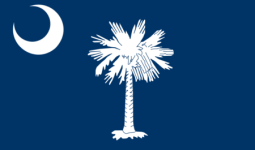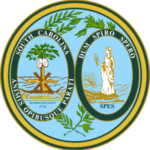South Carolina
South Carolina is a state in the Southeastern United States. It is bordered to the west by Georgia; to the north by North Carolina, to the east by the Atlantic Ocean, and to the south by Georgia.
- ABBREVIATION: SC
- NICKNAME: The Palmetto State
- POPULATION: 4,774,839 (2013 est.)
- CAPITAL: Columbia
- STATE BIRD: Great Carolina Wren
- STATE FLOWER: Carolina Yellow Jessamine
- AREA: 32,020 sq. mi.
- TIME ZONE: Eastern
- ENTERED UNION: May 23, 1788
- ALTITUDE: High, 3,560 ft. Sassafras Mountain
- CLIMATE: Humid, with long hot summers, short mild winters. Some snow in mountains and upper Piedmont.


“The Palmetto State” acquired its nickname from the luxuriantly fringed trees that shadow Fort Sumter in Charleston Harbor. Along the island-studded coast, cypresses soar, gum and bay trees tower, and spiky reeds jut up from across the swamps. On the higher areas of the Coastal Plain, water oaks and longleaf pines arch against the soft skies. Far inland, the “up country” of the Piedmont Plateau boasts a timberland of yellow poplars, black walnuts, sycamores, and other soft and hard woods. On the western border, in the highest part of the state, the Appalachian ridges are adorned with laurel, hemlock, and majestic oak. South Carolina’s profusion of trees makes the state a leader in the South’s growing forest industry, which is rising to challenge that of the Pacific Northwest.
Spaniards sailing from Santo Domingo in 1521 were the first Europeans to sight the virgin splendor of South Carolina. But the English, in 1670, founded the first permanent white settlement in the colony. One hundred years of defending themselves against sporadic attacks by the Spanish, as well as the French, native Indians, and thieving Pirates, gave the colonists a sturdy sense of independence. Inevitably, South Carolina was a leader in the American Revolution, and in 1860, maintaining what it considered its tradition of self-determination, South Carolina became the first state to secede from the Union.

Agricultural distress blighted the state from the time of the Civil War, and the fortunes of the economy remained low until the after World War II. In the 1950’s the Savannah River Plant opened, a 250,000-arcre atomic production complex that created new jobs while hydroelectric power from the state’s many rivers drew textile and other industries in quantity. The economy began to recover. Today, Tobacco remains closely woven into the economic life of South Carolina, no other crop brings so great a per acre profit to the State. More than half of South Carolina’s agricultural income is produced by livestock and livestock products, while chemical manufacturing and textile production continue to boost the economy. Like every other State in the Union, South Carolina is in the slow process of recovering from the recent recession.
FUN FACTS:
- Sand-hills along the western edge of the coastal plain are the remains of beaches from an ancient sea that once covered the area.
- Sullivan Island, off the coast of Charleston, is known as the Ellis Island of Slavery. It was here that more than 200,000 enslaved people from West Africa first set foot on American soil.
- Before it became known as the Palmetto State, South Carolina was known as the Iodine State because of the large quantities of this mineral found in its plants.
- Francis Marion earned the nickname Swamp Fox for his legendary ability to stage raids against the British and then disappear into the swamps of southern South Carolina during the Revolutionary War.
- The first French settlement in South Carolina was Parris Island, founded in 1562.
- Fort Sumter is home to the first battle of the Civil War.
